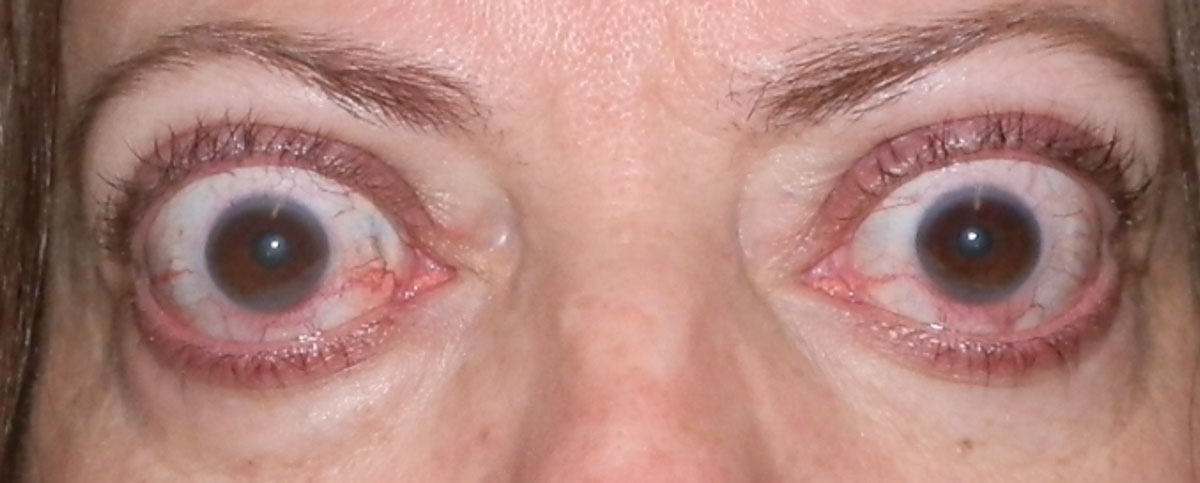Treatment of thyroid eye disease (TED) moved forward substantially in 2019 with the approval of teprotumumab (Tepezza), the first disease-specific agent developed for the condition. To help provide alternative and adjunctive therapies for individuals living with upper eyelid symptoms due to TED, a team of researchers recently published on a potential role for the oral agent tamsulosin. The prospective study appearing in the British journal Eye on Monday.
 |
|
Upper lid retraction seen in TED has a negative psychosocial effect on patients due to the typical “stare,” reported to cause social isolation, depression, anxiety and confidence decline. Photo: Bobby Saenz, OD, MS. Click image to enlarge. |
Eleven suitable patients (mean age 47.5; eight women) were given oral 0.4mg/day of tamsulosin for three months. At baseline and each visit after, upper eyelid margins-to-reflex distance (MRD1), vertical palpebral fissure height, subjective improvement, signs and symptoms of dry eye and lubricant use were assessed. Three patients discontinued taking the drug because of adverse effects of dizziness, bradycardia, nausea and gastrointestinal distress; however, all these resolved immediately after drug discontinuation. The other eight patients reported no side effects.
Five patients saw objective improvement in eyelid position and subjective improvement in eye discomfort. What’s more, mean MRD1 decreased by -1.04 ±0.81mm and mean palpebral fissure size decreased by -1.46 ±1.33mm. Mean duration of treatment with tamsulosin was 84.6 ±71.9 days. Discontinuation of the drug occurred due to no MRD1 improvement (n=3), referral for eyelid surgery with stable, inactive TED (n=2), treatment of intravenous methylprednisolone due to worsening active TED (n=2) and from patient choice after five months of treatment, citing spontaneous symptom resolution (n=1).
In the discussion section of their paper, the researchers elaborate on why this symptom of TED should warrant attention. Upper eyelid retraction occurs in up to 90% of these patients, and this can result in worsening corneal exposure from reduced blink and lagophthalmos, as well as leading to sight-threatening complications. These possibilities often force clinicians to address eyelid retraction early in the disease course, either in an active or inflammatory phase. This can be combatted with use of topical lubricants, improving corneal health and counteracting effects of increased sun exposure, but this may only work in mild or moderate cases. The recommended first-line treatment of systemic anti-inflammatory agents like steroids can improve symptoms of swelling, erythema and pain; however, they do not address eyelid retraction specifically.
There are other treatment options available for TED patients as well, most notably the on-label us of Tepezza, but oral tamsulosin has the benefit of being a non-invasive, daily oral route option. It is widely used for urologic indications already, offering generic preparations and possessing a well-established safety profile. A more natural appearance and improvement of exposure keratopathy can be seen in TED patients with just 1mm to 3mm, and this reflects the average -1.46 ±1.33mm seen of improvement in palpebral fissure height for the entire group of this study. However, 50% of patients had more than -2mm of change as well as self-reported subjective improvement in appearance and eye comfort.
Considering all of these factors, the authors write in their study that “tamsulosin is a safe potential treatment for eyelid retraction in TED and can be used as a temporary alternative therapeutic approach for patients unsuitable for surgery.” Naturally, more research needs to be performed before such an intervention would be clinically adopted.
| Click here for journal source. |
Arnon R, Goldberg H, Ben-Simon GJ, et al. Alpha-1 antagonist treatment for eyelid retraction in patients with thyroid eye disease—a prospective pilot study. Eye (Lond). October 21, 2024. [Epub ahead of print]. |


